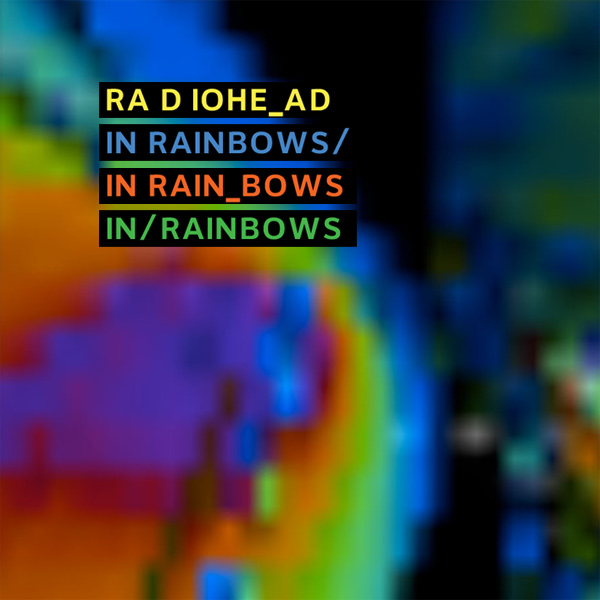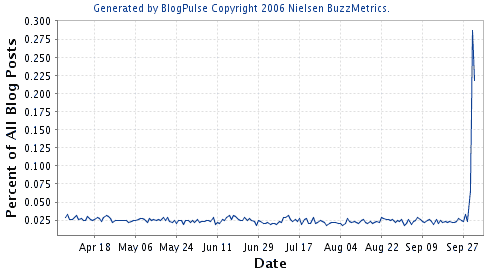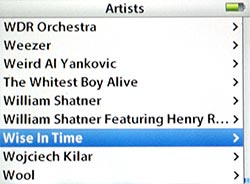Via this 9rules note:
HERE IS SOME INFORMATION ABOUT THE DOWNLOAD:
THE ALBUM WILL COME AS A 48.4MB ZIP FILE CONTAINING 10 X 160KBPS DRM FREE MP3s.
I haven’t placed an order for In Rainbows yet because I was waiting to find out the quality and format of the digital files. With this news I’m a little disappointed. Sure, 160kbps is quite *acceptable* but I consider 192kbps to be my minimum bitrate for MP3 (or did before I started encoding into AAC). Still, I assume the tracks are coming straight from the masters, so they’re bound to be decent. Even so, 160kbps seems like a strangely small format in this day in age.
All in all though, what this experience amounts to is a controlled (and profitable) “leak” for the band. Whether they succeed in up-selling the Discbox or traditional CD remains to be seen. Personally, I’m still debating whether there’s a Discbox with my name on it.
In any case, I’m sure the album will be fantastic. This is Radiohead we’re talking about.
Also strangely, the mp3s don’t come with any cover art included, though they otherwise have good ID3 tags (except for genre). Two images I’ve run across so far are this one, which looks like it could be from one of the vinyl sleeves:

And this one, which looks like it’s taken from the In Rainbows website:
::
Update 10/10: Having found out the format, I went ahead downloaded the album. I’m just glad I didn’t pre-pay a large amount for it. If I’m going to pay retail price for a record, I’m going to expect to be able to encode it at whatever quality I want. Having listened, the files sound fine in my ear buds and are certainly enjoyable enough for now, so I’m not going to make any further deal of it.
Albums by Radiohead always take a little while to grow on you. While they are never disappointing on the first listen, it takes some time before the gems are evident. I’m sure I won’t know quite what I think about In Rainbows for some time, but here are my first thoughts.
In Rainbows is perhaps the smallest departure in style in the band’s history, feeling like a continuation of the Hail to the Thief ethos, but with Amnesiac’s dour ambiance. Overall, the sense I get from the album is unambitious, but not staid. It is music of and for people who are weary. Of what, who knows? But true to the Radiohead mind-set, a detached alienation pervades the entire elaborated experience. To be sure, the music itself is as intricate as is to be expected, it just feels smaller and more straight-forward. There are no grand exclamations like Karma Police, mind-bending riffs like My Iron Lung or voyages into the unknown like Idioteque.
The other thing that strikes me right off the bat is that, for a rock band, this album doesn’t feature much in the way of rock. I don’t necessarily call that a bad thing. In fact, In Rainbows sounds so good as a whole that a massive rock song would feel totally out of place. It’s just unfortunate for me because Radiohead jams are some of my favorite things. I think they make up for it though with some down-right inspired percussion.
Initial song-by-song impressions:
15 Steps
A glitchy Bjork-like intro powers Thom Yorke’s trademark, though nearly unintelligible, falsetto in this up-tempo opener. The percussion here is the most interesting part, with the live drums providing body to the emphasized synth beats.
Bodysnatchers
Dirty distorted riffs, straight-end drums and wailing electronics make me want to dance on top of a haunted house.
Nude
This slow proto-waltz is mesmerizing in its stripped down simplicity.
Weird Fishes/Arpeggi
Gloriously clean arpeggios and a galloping rhythm make this one an early contender as my favorite from the album.
All I Need
A somber piano ballad builds to brilliant crescendo.
Faust Arp
A cello accentuates more arpeggios, this time played by a Spanish guitar, on this mellow tune. It’s possibly the most tender song in all of Radiohead’s repertoire.
Reckoner
Rounds out an elegiac trio of songs. All I Need, Faust Arp and Reckoner feel like they could easily meander by, unnoticed in a dream or on a dark foggy night, if they weren’t so captivating.
House of Cards
Thom’s vocals echo through the emptiness on what could be the B-side to Knives Out (if Knives Out didn’t already have b-sides).
Jigsaw Falling Into Place
The tempo finally picks back up on what it the most direct pop song on the record. It could be Sit Down. Stand Up’s little brother.
Videotape
A boy and his piano ponder the persistence of media and the cruel march of time. A bit of a downer to end the album on.
All in all a great album to listen to, though you might want to save for a soundtrack on a rainy day or you find yourself in too good of a mood.
Here’s a fan-vid featuring Weird Fishes/Arpeggi:






